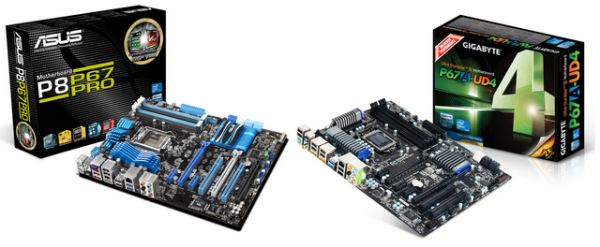The Battle of the P67 Boards - ASUS vs. Gigabyte at $190
by Ian Cutress on January 20, 2011 4:15 PM EST- Posted in
- Motherboards
- Gigabyte
- Asus
- P67
Final Words
Both the ASUS P8P67 Pro and Gigabyte P67A-UD4 motherboards offer a lot to consumers. For $190, we want a product that hits all the basic functionality of Sandy Bridge, and squeezes out as features and as much performance as possible at this price point.
For the ASUS board, we have a nice looking product with significant strengths in the implementation of their UEFI, and the auto overclockable functions available. The UEFI EZ mode/basic starting screen is something many manufacturers will copy over the upcoming months and UEFI visions. The auto-tuner section of Ai Suite will see use in all markets, aiding various retailers in offering ready-overclocked Sandy Bridge bundles with the P8P67 Pro. Intel gigabit Ethernet is nothing to be sniffed at, and the fan controls can only help improve the user experience. Also, bundle in that three-year warranty. On the downside, the BT GO! and Turbo Remote overclocking features via Bluetooth did not work for me.
The Gigabyte board performs on par with the ASUS board in terms of benchmarking – in most situations, there is almost nothing in it (except USB, where Gigabyte have the advantage there). The board is UEFI GUI absent (for now, supposedly), but thanks to BIOS updates, now supports 2.2TB+ hard drives. Overclocking via the BIOS is straightforward if you have ever overclocked before, and the myriad of software available in the OS will keep you hunting for options, trying to remember which setting is in which piece of software. The warranty, like the ASUS, is also three years. However, the BIOS updating issues I had are certainly worthy of note.
After playing with both boards, I can only come to one conclusion – if it were my money, I would take the ASUS P8P67 Pro over the Gigabyte P67A-UD4. With the ASUS board, you are getting a detailed UEFI, an awesome auto-overclocking tool, better energy saving features, a USB 3.0 bracket , more SATA 6 Gb/s ports, Intel gigabit Ethernet, and in my case, scope for a better overclock. The Gigabyte board is essentially expensive for what is on offer, in terms of usability, features, and extras.
However, the second question is: ‘what about the comparison to the ASRock P67 Extreme4’? The ASRock board has power/reset buttons on the board, a Debug LED, that USB 3.0 bracket which will hold an SSD (worth in my option about $15), and is almost $40 cheaper. The ASUS board is the slightly better performing, overclocking is easier on the ASUS, the ASUS has a longer warranty, the UEFI is slightly better on the ASUS, the ASUS uses Intel Ethernet rather than Realtek, but the ASRock will take socket 775 coolers. It is up to you to judge, but in my opinion, I would take the Extreme4, pocket the $40 difference, and invest it in something else for a PC build.
This then leads into the following question – ‘if I’d rather take a $150 board rather than a $190 board, why are there $300 boards available?’ That question is to be tackled over the coming months!











137 Comments
View All Comments
jigglywiggly - Thursday, January 20, 2011 - link
gr8 article and I liked the ending comparison to the asrock board, I'ma get that. Just has so many features.vol7ron - Thursday, January 20, 2011 - link
Can't see getting P67. Waiting on Z67. Hopefully it will be all I ever dreamed ofKaboose - Thursday, January 20, 2011 - link
Z68 they didn't stay with 67 on the "Z" chipset apparently.DanNeely - Friday, January 21, 2011 - link
Possibly since LGA 2011 will also use DMI to connect to the chipset Z68 boards will be sold for both sockets; and presumably some of the more mundane chipsets would be used for server/workstation builds.Etern205 - Friday, January 21, 2011 - link
LGA 2011 will use the X68 which is different than Z68.SB chipsets
Highend: LGA 2011/X68
Mainstream LGA 1155/Z68<--Allows for OCing.
vol7ron - Saturday, January 22, 2011 - link
Yep. It was either a typo or a finger fart :)Still, I'm hoping the processor batches will have improved by then. What I'm hoping for is the CPUs to mature a little bit, to possibly get a little higher BCLK overclock (not looking for much, just closer to the 5Mhz).
DanNeely - Sunday, January 23, 2011 - link
Don't hold your breath. The BCLK limit is most likely due to something on your PCI/PCIEe buses (neither of which are designed for any overclock at all) bombing out; not your CPU.medi01 - Friday, January 21, 2011 - link
Suddenly, paying 150-200$ for a motherboard is OK.After all, it makes Intel CPUs "cheaper".
MrSpadge - Sunday, January 23, 2011 - link
It's been like that for a long time. But personally I never saw the value in expensive motherboards.MrS
medi01 - Monday, January 24, 2011 - link
I don't recall it "being like that" for AMD motherboards.